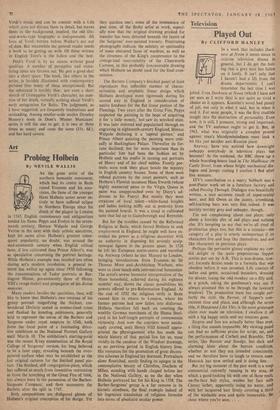Art
Probing Holbein
By NEVILE WALLIS
As the great artist of the northern humanist movement, which had its centre in Basle round Erasmus and his asso- ciates, the fame of the younger Hans Holbein seems never en- tirely to have suffered eclipse in Northern Europe since his death of the plague in London in 1543, English connoisseurs and antiquarians tended his flame. Pepys and Evelyn in the seven- teenth century, Horace Walpole and George Vertue in the next with their artistic anecdotes, kept his name alive. Holbein's greatest subse- quent popularity, no doubt, was around the mid-nineteenth century when English critical taste, if Iess cultivated than Prince Albert's, was as speculative concerning the portrait heritage. While Holbein's example was recalled less often during art's modern revolution, a general in- terest has welled up again since 1950 following the concentrations of Tudor portraits at Bur- lington House, pre-eminently those of Henry VIII's image-maker and propagator of his diving rnajestas.
Many readers besides the specialists, then, will like to know that Holbein's two versions of his group portrait magnifying the thickset, em- broidered Divinity seated in ermine-lined robes and flanked by kneeling petitioners, generally held to represent the union of the Barbers and Surgeons under royal auspices in 1540, both form the focal point of a fascinating detec- tive exhibition at the National Portrait Gallery until March 10. The exhibition's starting-point was the recent X-ray examination, of the Royal College of Surgeons' version, for long believed to be a later copy, revealing beneath the over- painted surface what may be established as the lost original cartoon for the finished panel pic- ture. The finished, stiff congregation-piece, which has suffered as much from insensitive restoration as from the scorching of the Great Fire of 1666, has always been in the possession of the Barber- Surgeons Company, and their successors the Barbers after the split in 1745.
Both compositions are disfigured ghosts of Holbein's original conception of his design. Yet they quicken one's sense of the immanence of past time, of the fleshy artist at work, especi- ally now that the original drawing pricked for transfer has been detected beneath the layers of the Surgeons' over-painted travesty. Penetrating photographs indicate the subtlety or spirituality of some obscured faces of wardens, as well as the closeness of the King's countenance to the cottage-loaf inscrutability of the Chatsworth Cartoon, in this probably irrecoverable drawing which Holbein no doubt used for the final com- mission.
The Barbers Company's finished panel at least reproduces that inflexible marrner of charac- terisation and emphatic linear design which Holbein developed more rigorously during his second stay in England in consideration of native fondness for the flat linear pattern of the Flemings. Two years after the Great Fire, Pepys inspected the painting in the hope of acquiring it for 'a little money,' but saw its wrecked state. It was later restored and popularised through an engraving in eighteenth-century England, Horace Walpole declaring it a 'capital picture,' and Prince Albert quizzing the painting more criti- cally at Buckingham Palace. Thereafter its for- tune declined; but far more important than its particular fate had been the fashion set by Holbein and his studio in turning out portraits of Henry and of his chief nobles. Family por- traits soon took their place beside the tapestry in English country houses. Some of them were refined pictures by the court painters, such as Holbein's Flemish successor Hans Eworth (whose highly mannered paean to the Virgin Queen in paint was unapproached even by Dizzy's ad- dresses to his Faery). But mostly they were creations of local talent—white-faced knights and ladies looking stiffly out at posterity from the painted boards. It was a trend in cultivated taste that led up to Gainsborough and Reynolds.
But for the troubles caused by the Reformed Religion at. Basle, which forced Holbein to seek employment in England, he might well have ex- tended his power as a religious decorator with an authority in disposing his severely sculp- turesque figures in the picture space. In 1526 he left his European storm-centre and travelled via Antwerp (where he met Massys) to London, bringing introductions from Erasmus to. Sir Thomas More and.darchbishop Warham, who were in close touch with international humanism, The artist's serene humanist interpretation of the More household, achieved during his eighteen months' stay, shows the classic possibilities his powers offered to pre-Reformation England. At the end of 1532 the religious strife in Basle caused him to return to London, where his former patrons had now fallen into disfavour. Holbein therefore fell back on courting the wealthy German merchants of the Hansa Steel- yard in his half-length portraits of consummate virtuosity. And now the courtiers were assidu- ously courted, until Henry VIII himself appro- priated the physiognomist who has made the whole history of that period live for us, most vividly in the candour of the Windsor drawings, as no previous period in English history fives, His resources for the promotion of great decora- tive schemes in England lay dormant. Portraiture alone flourished, surely finding its apogee in the contemplative beauty of Christina, Duchess of Milan, standing with hands clasped before her in the National Gallery, as on the day when Holbein portrayed her for his King in 1538. The Barber-Surgeons' group is a far remove in its hieratic aloofness, the final example indeed of his ingenious translation of religious formula: into terms of absolutist secular power.






























 Previous page
Previous page